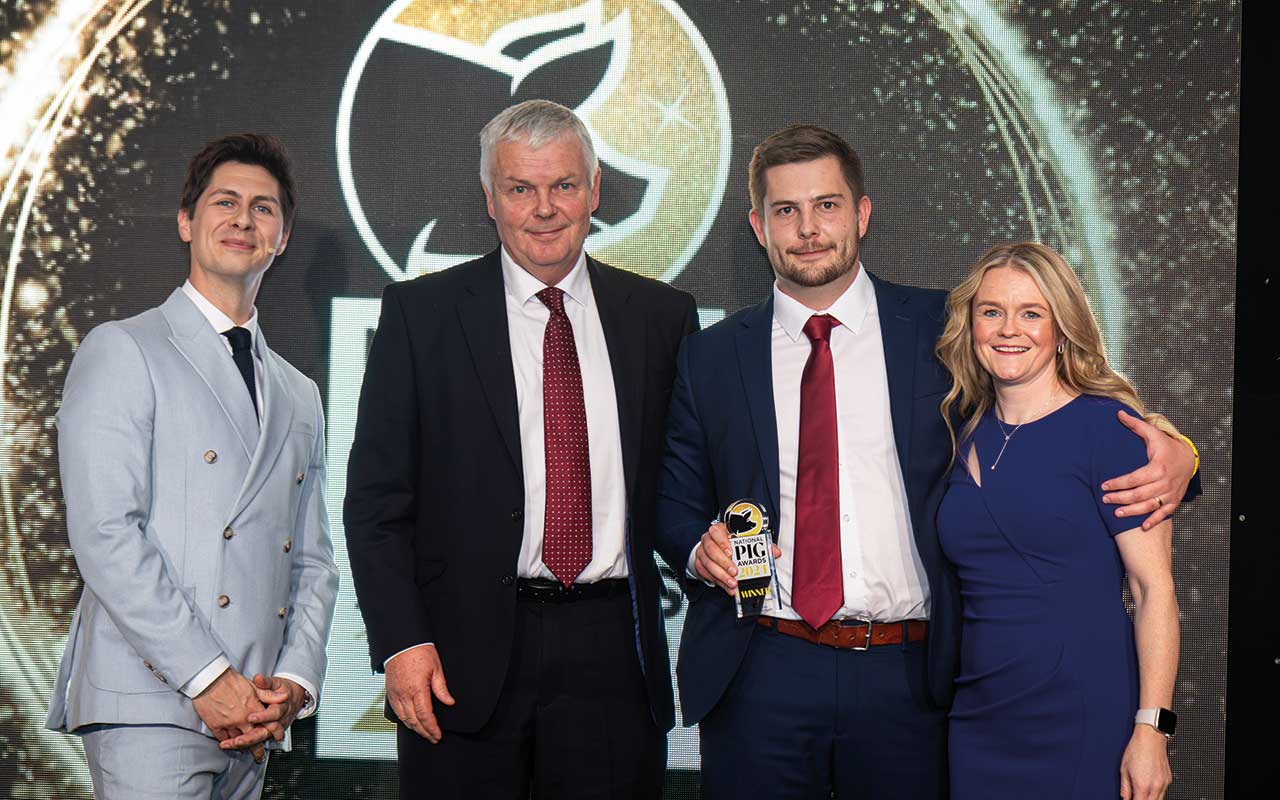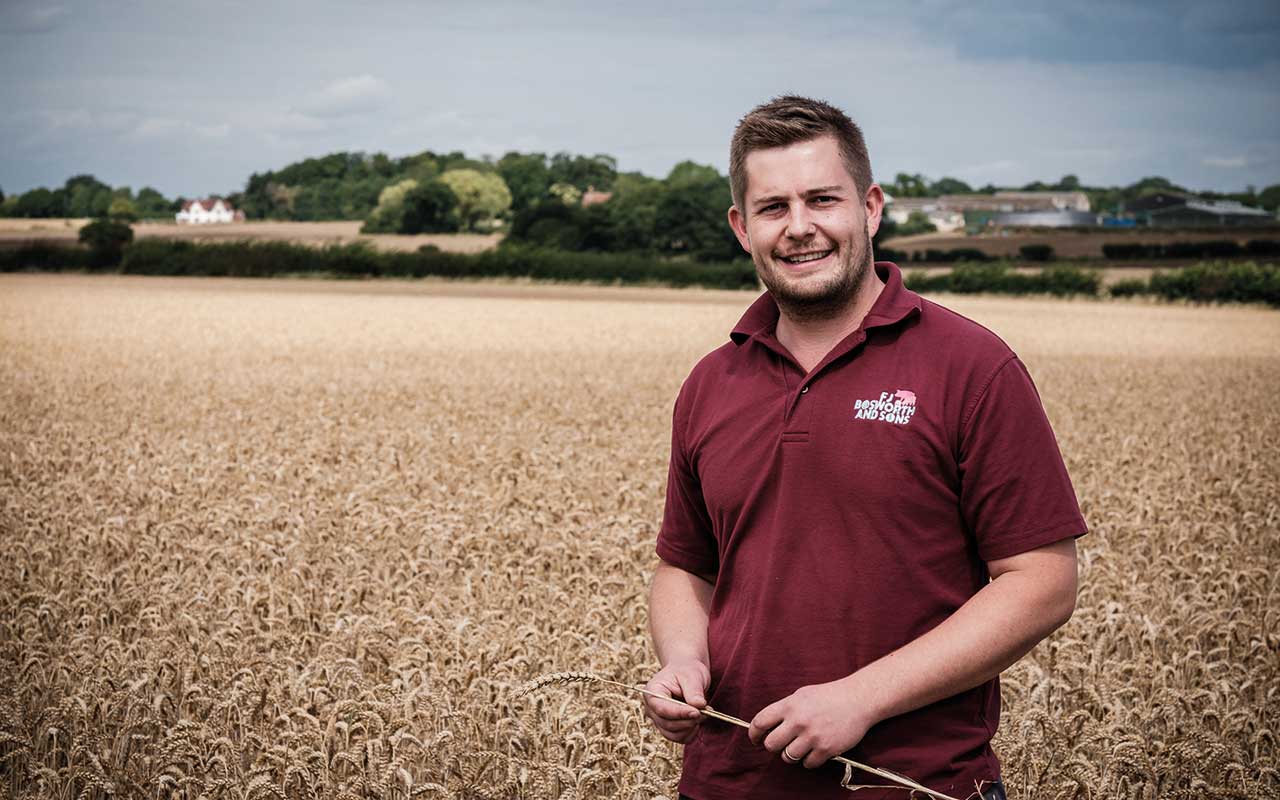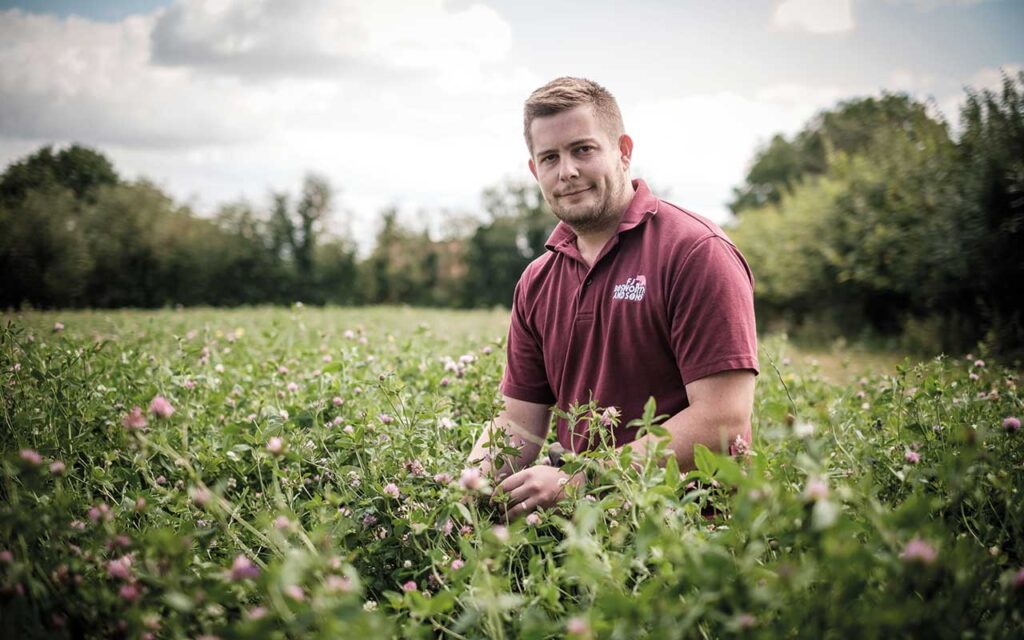To be sustainable, pig producers, first, must be financially viable, according to Jack Bosworth, who farms pigs and arable land in partnership with his family, including his dad, Stuart, in Essex.
FJ Bosworth & Sons is reducing its environmental impact wherever possible and has set the business on a pathway to do more, with the long-term aim of being able to sell ‘net-zero’ branded pork.
As winners of the 2024 Sustainable Farming Award, the Bosworths are committed to reaching net zero across their mixed farming business, with a 550-sow indoor farrow-to-finish herd, 330ha of arable land, plus contracting and pork processing enterprises.
Nearly half of the progeny go to a contract finisher unit in Norfolk, with the rest finished on the home farm.
Jack is realistic about the current sustainability challenges for the business, relating to both farm inputs and outputs. “In order to even look at how we can reduce environmental impact or deliver environmental benefits, we have to be sustainable financially,” he explained.
Their overarching strategy is to retain control as long as possible along the pork supply chain, by directly managing as much of it as they can.
The Bosworths invested in an existing sausage-making business last year to enable access to both wholesale and retail markets via an already established brand in East Anglia. Meanwhile, at the beginning of the pig production journey, they have close control of feed, milling and mixing their own diets.
“Being as close as possible to self-sufficient in cereals is a big priority,” said Jack. “We have been able to increase our land holding by about 25%, thanks to the pigs.”
They rent from neighbouring farms and offer them pig muck and slurry, meaning they are able to grow additional cereals in rotation with their landlords’ grass, while also putting more area into their manure management plan.

Carbon auditing
Their first carbon audit was carried out in 2023 by Ceres Rural, which was fully funded through the Future Farm Resilience Fund. “We didn’t have any idea of our present position on carbon emissions, with only limited data, and it really opened our eyes,” said Jack. “But it raised more questions than answers.”
For example, the business is using its own slurry and manure, minimising the emissions from the manufacture and transport of synthetic fertiliser.
“But muck has a relatively low nitrogen availability compared to synthetic fertiliser, meaning its nitrogen use efficiency [NUE] is rated as quite poor,” Jack explained.
“Our slurry and manure is a sustainable by-product from our primary rearing of livestock. It requires no further processing and doesn’t need to travel to the farm, but it actually puts us at a disadvantage to farmers without livestock when assessing NUE.”
The audit results for the pig enterprise showed feed accounted for 96% of carbon emissions and, in turn, 84% of the emissions from feed were attributed to soya.
With home mill-and-mix facilities on both sites, the business has the ability to adjust recipes and since 2018 has reduced soya inclusion in the pig diets from 20.7% to 14.9%, with cold-pressed rapemeal inclusion increasing from 2.5% to 10%, for example.
“There will be a reduction in our carbon emissions as a result, but it costs another 50p/t to produce,” Jack added.
“We’re absorbing that cost at the moment as we’ve committed to moving towards net zero, but if pig prices shift, we may not always be able to.
“There has been no money coming in for trialling new rations, nor reward for the end product from the supply chain. There is nothing to say, for example, that if you reduce soya by 10%, you’ll make another £5 per pig.
“We had a lot of conversations with our nutritionist, Andrew Zarkos Smith, about replacement protein, but there is no easy answer. Peas and beans would never replace all the soya, as we couldn’t grow enough without displacing the wheat area.”
Jack suggests the industry could aim to keep an amount of soya in rations and work towards UK-grown soya, with seed companies and government investing in variety research to support UK soya development.

Standardised data needed
“We want to lead the way on environmental sustainability and make changes as quickly as we can, and we need the data to make these decisions.
“But we don’t know what the best tool is to invest in,” Jack said, expressing his frustration that the audits work on one year of data, which does not chime with most farming decisions.
The Bosworths have joined the AHDB baselining project, which is supporting measurement of the farm’s environmental impact over a five-year period. “We’ve just done our soil sampling and are looking forward to those results. ADAS will also be doing a carbon audit, and it will be really interesting to see the differences between that and our first audit,” said Jack.
Highlighting his desire to sell net-zero pork in future, he believes environmental credentials could be as powerful as welfare in the long term when it comes to marketing.
But to achieve credible net-zero branding, pig businesses would need to be careful about what is put on product labels and what underpins them, Jack pointed out.
“The whole of agriculture wants to do something about its environmental impact, but it’s not easy,” he said.
“There has to be standardisation of carbon measurement and calculation methods across the industry before we can make real progress. That includes what time of year or period of time emissions are measured, who is collecting the data and who is authenticating it.”
Environmental investments
The removal of the Sustainable Farming Incentive and Countryside Stewardship makes things even more challenging.
Environmental schemes have provided benefits for the farm. For example, they have planted cover crops over winter, which reduced soil run-off and erosion while fixing nitrogen and boosting wildlife.
The business uses grants wherever possible to help reduce cost of production and improve efficiency. To date, this has included electronic sow feeders, a direct drill and umbilical slurry application equipment, which has helped to pick up more contracting work and achieves environmental benefits.
“In the latest round of grant funding, we’ve applied for a robotic pressure washer and a trailing shoe to further reduce emissions, odours and losses during slurry application,” said Jack.
Pig performance
Pigs are currently performing brilliantly, with an extra six pigs per gilt per year achieved over the past three months, contributing to a herd average of 35.64 liveborn/sow/year and 34.05 weaned/
sow/year.
It is difficult to say exactly what is behind the improvements, Jack said. “Having the right people in place and giving them the right tools to do the job well is important, as well as being available to the team and communicating well. Consistent attention to detail is a key factor,” he said.
“There are our relationships with suppliers, too, such as the vet, nutritionist and agronomist, who have a real impact. You need to find the right suppliers, put trust in them and follow their advice. Our vet, Joe Lunt, has made a massive difference. He is really committed and encouraging, and staff feel his enthusiasm.”
The electronic sow feeders have improved accuracy and helped reduce feed wastage, while running their own mill-and-mix system means they can adjust diets overnight if needed.
“Having a high level of control of the production process from end to end is great for product quality,” Jack added.
Processing enterprise
The Bosworths bought an established retail and wholesale business in 2024 and have put in a planning application, which, if granted, would enable them to develop a state-of-the-art production facility on the farm. Pigs would go to the abattoir and return to the farm for butchery.
“It means increased borrowing in the short term, but hopefully we can reduce food miles, increase the product range, boost value through existing customers and open up to new customers, while creating local employment opportunities,” said Jack.
Carcase balance is also hugely important to the business, and the fact that all its pork shoulders can go into sausages again highlights how it is putting itself in a position to solve more of its own problems.
“We believe we can manage nearly every part of our supply chain better than someone else can. You’ve got to back yourself,” Jack said.




